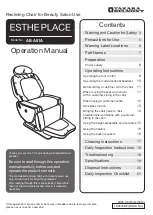
Introduction
©
2016-2017 SR Research Ltd.
3
unit). The lens and illuminator components allow for a more compact enclosure,
while supplying the high light output and sensitivity required for fast sampling
rates and low noise levels. All image processing and data recording is handled
by a laptop or desktop Host PC, which connects to the eye tracker with a high-
speed USB 3.0 cable.
The eye tracking unit can be mounted on a tripod and sit below the display that
the participant views during the experiment. If a laptop is used as a Display
computer, a laptop mount option can be used so that eye tracking can be done
on the laptop screen. Since the EyeLink Portable Duo’s eye tracking unit is near
the stimulus display, no electronics need to be near the participant’s head. The
eye tracker can operate in either a head-stabilized mode (any head support can
be used) or in a head free-to-move Remote mode.
Figure 1-2. Example Use Scenarios (Left: Eye Tracker
Mounted on Top of a Tripod; Right: Eye Tracker
Installed on a Laptop Mount)
1.1.2 Host PC
The EyeLink Portable Duo Host PC performs real-time eye tracking at either up
to 2000 samples per second while computing the gaze position of the
participant on the Display PC’s monitor. The Host PC also performs on-line
detection and analysis of eye-motion events such as saccades, blinks, and
fixations. In addition to the sample data, these events are stored in a data file
on the Host PC. They can be sent via the Ethernet link to the Display PC with
minimal delay, or output as analog signals (if the optional analog/digital I/O
card is installed in a workstation Host PC). From the Host PC, the operator
performs participant setup and monitors the viewing position of the participant
during the experiment.














































